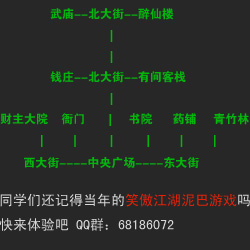先前,我们曾经描述过沿着“偏好图”的坐标轴走向极端的情况,如果那样做的话MUD会彻底失去其MUD性(MUDness)。这已经被注意到了,但是,沿着坐标轴走到极端并不是唯一颠覆MUD平衡的方式。
如果过分接受某一种类型玩家的话会发生什么?MUD将有些矫枉过正(overcompensated in their favour)?
当MUD过度向着成就型玩家倾斜的时候会破坏其游戏性(gameplay)。玩家需要花很多时间来学习新技能以提高自己在游戏中的地位,这样游戏中其他玩家就没有存在的必要了。这样做游戏就变成了一个单人冒险游戏(或许叫SUD / Single-User Dungeon?)了。
当MUD过度向着探索型玩家倾斜的时候会增加游戏的深度和趣味,但是会失去很多行为。看得见的东西将会压倒行为(spectacle would dominate over action),进而其他玩家也就变得不是必须的了。最终导致这基本上变成一本在线书籍。
当MUD过度向着社交型玩家倾斜的时候会完全削弱其游戏性而关注与玩家交流。最后,虚拟世界的感觉小时了,我们拥有的只是一个聊天工具或者IRC风格的IM程序。
完全迎合杀手型玩家会比较困难,因为杀手型玩家一类与其他玩家的存在而存在。过度强调杀人带来的痛苦会牺牲掉杀人过程中的刺激以及在逆境中快速思考核使用技能的智慧(但也非常暴力)。换句话说,这会使MUD变成一种普通的家用机游戏(arcade)(比如射击游戏)。
这是一个平衡问题:如果在MUD中增加了某种要素导致“兴趣图”倾向一方,那么还需要向反的地方增加一些机制以(倾向于“自动”)抵消前者的作用。否则,MUD就会变成担任冒险游戏、或者是一本书、或者一个聊天工具、或者是射击游戏。正是综合了各种因素,MUD才变得独一无二。同时特别,可以说在任何一个方向上走的太远的系统都不再是一个MUD;不能说在任何一个方向上都走的不太远的系统就不再是一个MUD。不论何时,仅仅需要系统是一个(文本模式的)多用户虚拟世界,一切就足够了。
SUMMARY
回答前言里所提出的问题,MUD是否属于:
“游戏(games)”么? 类似象棋、网球、AD&D(桌面文字游戏)一样?
“消遣(pastimes)”么?类似读书、浇花、做饭一样?
“运动(sports)”么? 类似打猎、射击、钓鱼一样?
“娱乐(entertainments)”么? 类似夜总会、电视、音乐会一样?
ENDNOTES
[1] 该文件是在1996年四月时对我先前“Who Plays MUAs”(Bartle, 1990a)一文的整理扩充。作为结论,同时我并不是一个科班出身的心理学家,请不要希望我用那些通常的术语和方法来分析我的论点。
This paper is an April 1996 extension of an earlier article, "Who Plays MUAs" (Bartle, 1990a). As a result of this, and of the fact that I am not a trained psychologist, do not expect a conventionally rigorous approach to the subject matter.
在不改动原文的基础上,允许非商业性的自由学术发布。
Permission to redistribute freely for academic purposes is granted provided that no material changes are made to the text.
[2] 在下图中,绿色代表人数增加,红色代表人数减少。绿箭头红线代表减少一方的人数将会导致增加另一方的人数。红箭头绿线表示增加一方的人数将会导致减少另一方的人数,以此类推。线条的粗细代表强调的效果:细线代表效果很小;普通线条可以粗略的人为两边受影响的人数相同;粗线条代表有非常明显的效果,起放大效果。
REFERENCES
Aspnes, J. (1989). TinyMUD [C] http://ftp.tcp.com/ftp/pub/mud/TinyMUD/tinymud-pc.1.0.tar.gz
Bartle, R. A. (1985). MUD2 [MUDDLE] MUSE Ltd, Colchester, Essex, UK.
Bartle, R. A. (1990a). Who Plays MUAs? Comms Plus!, October/November 1990 18-19.
Bartle, R. A. (1990b). Interactive Multi-Player Computer Games. MUSE Ltd, Colchester, Essex, UK ftp://ftp.lambda.moo.mud.org/pub/MOO/papers/mudreport.txt
Bruckman, A. S. (1992). Identity Workshop: Emergent Social and Psychological Phenomena in Text-Based Virtual Reality. MIT Media Laboratory, Cambridge, Massachusetts. ftp://media.mit.edu/pub/asb/papers/identity-workshop.ps
Bruckman, A. S. (1993). Gender Swapping on the Internet Proc. INET-93 ftp://media.mit.edu/pub/asb/papers/gender-swapping.txt
Bruckman, A. S. & Resnick, M. (1993). Virtual Professional Community: Results from the MediaMOO Project. MIT Media Laboratory, Cambridge, Massachusetts. ftp://media.mit.edu/pub/asb/papers/convergence.txt
Bruckman, A. S. (1994a). Workshop: "Serious" Uses of MUDs? Proc. DIAC-94 ftp://media.mit.edu/pub/asb/papers/serious-diac94.txt
Bruckman, A. S. (1994b). Approaches to Managing Deviant Behaviour in Virtual Communities. MIT Media Laboratory, Cambridge, Massachusetts. ftp://media.mit.edu/pub/asb/deviance-chi94.txt
Burka, L. P. (1995). The MUDline. http://www.ccs.neu.edu/home/lpb/mudline.html
Carton, S. (1995). Internet Virtual Worlds Quick Tour: MUDs, MOOs and MUSHes: Interactive games, Conferences and Forums Ventana Press, Chapel Hill, North Carolina.
Caspian-Kaufman, J. (1995). Sid Meier's CivNET: Instruction Manual Microprose, Hunt Valley, Maryland.
Cherny, L. (1995a). The Modal Complexity of Speech Events in a Social MUD. Electronic Journal of Communication, Summer 1995. ftp://bhasha.stanford.edu/pub/cherny/ejc.txt
Cherny, L. (1995b). The Situated Behaviour of MUD Back Channels. Dept. Linguistics, Stanford University, California. ftp://bhasha.stanford.edu/pub/cherny/aaai.ps
Clodius, J. A. (1994). Concepts of Space in a Virtual Community. http://tinylondon.ucsd.edu/~jen/space.html
Curtis, P. (1992). Mudding: Social Phenomena in Text-Based Virtual Realities. Proc. DIAC-92 ftp://ftp.lambda.moo.mud.org/pub/MOO/papers/DIAC92.txt
Curtis, P. & Nichols, D. A. (1993). MUDs Grow Up: Social Virtual Reality in the Real World. Xerox PARC, Palo Alto, California. ftp://ftp.lambda.moo.mud.org/pub/MOO/papers/MUDsGrowUp.txt
Dibbell, J. (1993). A Rape in Cyberspace. The Village Voice, December 21, 1993. ftp://ftp.lambda.moo.mud.org/pub/MOO/papers/VillageVoice.txt
Emert, H. G. (1993). "X" Marks the Spot. East Stroudsburg University, Pennsylvania. http://www-f.rrz.uni-koeln.de/themen/cmc/text/emert.n01.txt
Eddy, A. (1994). Internet After Hours Prima, Rocklin, California.
Epperson, H. L. (1995). Patterns of Social Behaviour in Computer-Mediated Communications. Dept. Sociology, Rice University. http://www.eff.org/pub/Net_culture/Misc_net_culture/ web_social_behaviour.paper
Evard, R. (1993). Collaborative Networked Communication: MUDs as System Tools. Proc. LISA-93 http://www.ccs.neu.edu/home/remy/documents/cncmast.html
Fanderclai, T. F. (1995). MUDs in Education: New Environments, New Pedagogies. Computer-Mediated Communication Magazine, 2(1), 8.
Farmer, F. R., Morningstar, C. & Crockford, D. (1994). From Habitat to Global Cyberspace. Proc. CompCon-94, IEEE http://www.communities.com/paper/hab2cybr.html
Kort, B. (1991). The MUSE as an Educational Medium BBN Labs, Cambridge, Massachusetts. ftp://musenet.bbn.com/pub/micromuse
Mauldin, M. L. (1994). Chatterbots, TinyMUDs and the Turing Test: Entering the Loebner Prize Competition. Proc. AAAI-94 http://fuzine.mt.cs.cmu.edu/mlm/aaai94.html
Moock, C. (1996). Virtual Campus at the University of Waterloo. http://arts.uwaterloo.ca:80/~camoock/virtual_classroom.htm
Norrish, J. (1995). MU*s. http://www.vuw.ac.nz/~jamie/mud/mud.html
Poirier, J. R. (1994). Interactive Multiuser Realities: MUDs, MOOs, MUCKs, and MUSHes. The Internet Unleashed, 1192-1127. SAMS Publishing, Indianapolis, Indiana.
Reid, E. (1994). Cultural Formations in Text-Based Virtual Realities. Dept. English, University of Melbourne, Australia. ftp://ftp.lambda.moo.mud.org/pub/MOO/papers/CulturalFormations.txt
Riner, R. D. & Clodius, J. A. (1995). Simulating Future Histories: The NAU Solar System Simulation and Mars Settlement. Anthropology & Education Quarterly 26(1):95-104. http://tinylondon.ucsd.edu/~jen/solsys.html
Rosenberg, M. S. (1992). Virtual Reality: Reflections of Life, Dreams and Technology. An Ethnography of a Computer Society. ftp://ftp.lambda.moo.mud.org/pub/MOO/papers/ethnography.txt
Roush, W. (1993). The Virtual STS Centre on MediaMOO: Issues and Challenges as Non-Technical Users Enter Social Virtual Spaces. MIT Media Laboratory, Cambridge, Massachusetts. ftp://media.mit.edu/pub/MediaMOO/Papers/STS-Centre
Urdang, L. & Manser, M. (1980). The Pan Dictionary of Synonyms and Antonyms Pan Reference, London, UK.
Whitlock, T. D. (1994). Fuck Art, Let's Kill!: Towards a Post Modern Community. gopher://actlab.rtf.utexas.edu/00/art_and_tech/rtf_papers/pmc.terrorism
Whitlock, T. D. (1994b). Technological Hierarchy in MOO: Reflections on Power in Cyberspace http://www.actlab.utexas.edu/~smack/papers/TechHier.txt

